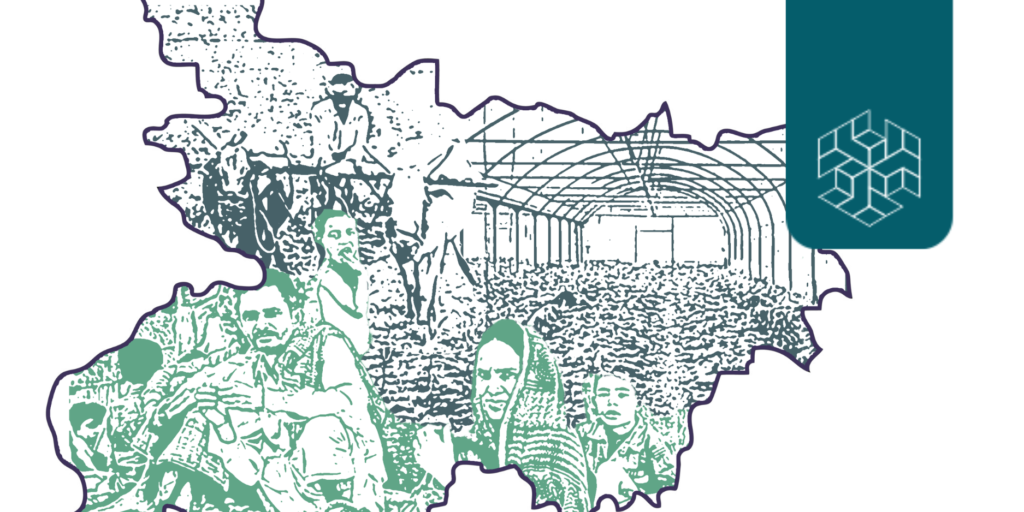Authored by: Akshita Sharma
Edited by: Sara Bardhan, Riya Singh Rathore
The irrigation-energy nexus in India’s agricultural sector is characterised primarily by depleting groundwater and a growing debt burden of power distribution companies (or DISCOMs) due to massive power subsidies that remain underfunded by the state governments. To address the burden, the Government of India [GOI] has been promoting solar irrigation pumps [SIPs] by offering substantial investment subsidies. SIPs promise a low carbon footprint, consistent energy availability, zero fuel costs, and low operational costs.
TOWARDS SOLVING THE IRRIGATION-ENERGY NEXUS: DEBATES ON POTENTIAL AND VIABILITY OF SIPs
The groundwater economy in the west-south corridor that spans from Punjab to Tamil Nadu holds lesser groundwater availability than the Ganga-Brahmaputra Belt. It is dominated by electric water pumps for irrigation. This domination led to severe water table depletion, eventually snowballing into the DISCOMs crisis (Table 1). Farmers in this corridor also face frequent power cuts, low voltage, and receive stable electricity only during the night.
Table 1: Electricity tariffs and subsidies to the agriculture sector for 2014-15
| State | Power Tariff – Agricultural Consumer [INR] | Subsidy to Agricultural Power [INR million] |
| Haryana | 0.08 – 0.10 | 52,840 |
| Punjab | 0 | 44,540 |
| Maharashtra | 2.1 | 35,000 |
| Andhra Pradesh | 0.50 – 1.0 |
43,000 |
| Tamil Nadu | 3.22 | 32,600 |
| Gujarat | 0.6 | 11,010 |
| Madhya Pradesh | 3.20 – 4.05 | 59,050 |
Source: Water and Agriculture in India
The west-south corridor will benefit significantly from the introduction of SIPs since the region has many solar hotspots and receives peak sunlight hours, ensuring a regular and efficient supply of electricity to farmers. It will also help relieve the DISCOMs subsidy burden from INR 30,000 to 35,000 per year, per SIP. Additionally, SIPs will also help move towards zero carbon footprint in the groundwater economy by decreasing reliability on fossil fuel-based electricity production. The only possible drawback of SIPs could be the risk of the over-exploitation of groundwater since on-demand cheap power will always be available post introduction of SIPs in the corridor.
The government has introduced several solar irrigation schemes, such as PM-KUSUM, Surya Raitha Scheme in Karnataka and Suryashakti Kisan Yojana [SKY], to increase the uptake of SIPs and disincentivise overuse of groundwater. Another programme called Solar Power as a Remunerative Crop [SPaRC] was initiated in Gujarat by the International Water Management Institute (IWMI). These schemes provide subsidies to farmers by covering the capital cost of SIPs with a capacity of up to only 7.5 horsepower [HP] because such SIPs extract less water per minute. The preference in these schemes are given to those farmers who are already using water-saving micro-irrigation systems or are open to doing so. However, this criteria for availing subsidies may benefit only medium and large farmers as they are more likely to have a micro-irrigation system in place. This means that on top of the 50% to 90% subsidy for micro-irrigation, they may also benefit from the subsidies for solar irrigation.
Another factor which may make SIPs more affordable is the falling price of solar photovoltaic [PV] cells, used in SIPs to convert light energy into electrical energy. However, with their increasingly cost-effective prices, one can expect an expansion of non-subsidy markets for SIPs in the private sector, which can make it difficult for the government to keep groundwater exploitation in check.
Despite subsidies, the initial capital investment remains high, raising questions about the viability of SIPs. The operation and maintenance of solar PV systems require trained professionals and machine components which may be hard to find in rural areas. To overcome the obstacle, the Suryamitra Skill Development Programme by the MNRE aims to upskill youth for employment opportunities in the growing Solar Energy Power Project in India and abroad.
However, the continued use of diesel pumps instead of solar pumps poses a serious concern. While usage of the former may aggravate groundwater depletion, farmers practically have no incentive to switch to solar pumps because of existing power subsidies schemes and the negligible cost of extracting water.
SELLING SOLAR POWER AS A REMUNERATIVE CROP
To curb the usage of diesel pumps in the west-south corridor, the International Water Management Institute (IWMI) has proposed incentivising farmers to sell solar power as a remunerative crop. Under the SPaRC programme, farmers can sell surplus solar power produced back to the power grid. This alternative will incentivise farmers to conserve groundwater and energy, increase farmer income, and enable more efficient irrigation by encouraging farmers to adopt crops with high returns to irrigation. The programme includes a balanced incentive, comprising a capital cost subsidy and Feed-in Tariff [FiT] paid to the farmers for the energy they sell back through grid-connected solar pumps.
The Surya Raitha solar irrigation scheme in Karnataka has provisions for buying back surplus solar power from SIP owners at an attractive FiT. The capital-cost subsidy and buy-back of surplus power combo earn a farmer a “net additional income INR 76,000 by the sale of surplus solar energy and abolishes the carbon footprint of groundwater irrigation”, while the DISCOM saves INR 56,000 annually.
However, a higher than optimal FiT could lead to malpractice where farmers may continue using diesel and electric pumps while selling all of the solar power generated or may only grow solar power, forgoing other crops. Nonetheless, evidence from Dhundi in Gujarat shows that even though farmers had been offered a high FiT as part of the SPaRC programme, there was no sign of a fall in agricultural production. The study concludes that higher FiT is more likely to improve incomes and help farmers grow more crops.
Meanwhile, the Ganga-Brahmaputra Basin in the eastern corridor is a water-rich and flood-prone area dominated by diesel water pumps. The recent rise in diesel prices has naturally increased the costs of irrigation. Thus, the benefits of adequate irrigation have not been fully realised in this region which threatens to stagnate groundwater irrigation altogether. According to a study in Uttar Pradesh, out of 86% of all farmers with irrigation access on all lands, 51% were dissatisfied with irrigation because of the depleting water table and high diesel expenses.
Therefore, introducing SIPs in this region may boost agricultural growth while curbing the need to lay rural electric networks. However, practices that work efficiently in the west-south corridor may not translate to Eastern India due to the latter receiving less sun time. This may make solar power generation more expensive for farmers in the east-north corridor.
Moreover, subsidies on electricity make renting diesel pumps or cheap pumps imported from China a more economical option, whereas purchasing SIPs cost farmers INR 1,00,000 or 1,12,500 per unit even after subsidies. Therefore, for small and marginal farmers in the Ganga-Brahmaputra Basin, the costs of installing SIPs are unaffordable. About 40% of all farmers surveys in Uttar Pradesh expressed that SIPs are too expensive. The intensity of cropping and irrigation is comparatively high in the east-north corridor, which means that less barren land is available for installing solar arrays.
The absence of a decision on how many wells will be installed with grid-connected solar power presents serious concerns around selling solar power back to the grid. He also estimates the financial costs associated with grid connection to be enormous. For instance, installing a 100-kilowatt solar-powered system to an electricity grid costs around INR 0.85 crore. This estimate includes the cost of the solar PV device, power conditioning equipment, safety equipment, meters, and installations. Citing their non-viability, the Centre for Science and Environment stated that SIPs might not be the silver bullet to solve the irrigation-energy nexus.
Despite these reservations, SIPs are being viewed as the answer to erratic power supplies, the DISCOMs crisis, and a more sustainable source of irrigation by the government. However, SIPs have faced limited uptake by farmers despite substantial capital cost subsidies and new government programmes.
POLICY RECOMMENDATIONS: MITIGATING DRAWBACKS AND IMPROVING ADOPTION OF SIPs
The following are recommendations for improving adoption, viability and benefits from the solar irrigation move:
- Deploy awareness programmes about efficient water management practices and benefits of SIPs through existing networks of farmers via the Ministry of Agriculture and Ministry of Water Resources.
- Promote Joint Liability Groups [JLG] among small and marginal farmers constrained by resources to invest in SIPs. Through JLGs, farmers can jointly take a loan and purchase solar pump/s to own and share collectively. JLGs will also build collective trust to not engage in any malpractices and make it an easy point for surplus power monitoring by DISCOMs.
- Assess the best FiT and capital cost subsidy balance to ensure that SIPs are economically viable to not only farmers but also the government while warranting equity in access to all.
- Ensure better inclusivity of marginal farmers in existing solar irrigation schemes. Promote smaller (sub-HP to 3HP) solar pumps through capital subsidy for marginal farmers and strengthen the financial ecosystem rather than offering capital subsidy support to medium and large farmers.



